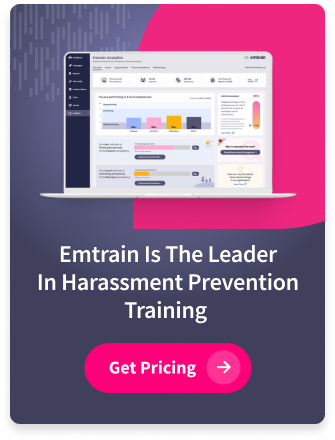The Leadership Challenge: Moving From Compliance to Culture
When HR leaders evaluate inclusion training programs, the question isn’t just about curriculum breadth—it’s about business impact. While many organizations approach diversity, equity, and inclusion training as a compliance checkbox, leading companies recognize that strategic inclusion programs deliver measurable returns through reduced turnover, improved team performance, and enhanced employer brand.
The stakes are clear: organizations with strong inclusion cultures experience 22% lower turnover rates and 27% higher profitability, according to recent workplace analytics data. Yet many executives struggle to connect their DEI investments to tangible outcomes.
The Cost of Getting It Wrong
Before exploring what works, it’s worth understanding what’s at stake when inclusion training fails. Beyond the obvious compliance risks, organizations face substantial hidden costs: talented employees leaving for more inclusive competitors, teams operating below their potential due to psychological safety gaps, and damage to employer brand that makes recruiting increasingly difficult and expensive.
Consider the compounding effect: when high-performing employees from underrepresented groups leave, they take institutional knowledge, client relationships, and often recruit former colleagues to their new employers. The total cost extends far beyond the standard turnover calculations. Meanwhile, teams that lack inclusion competency spend countless hours managing interpersonal conflicts that more skilled managers would prevent entirely.
What Separates Effective Inclusion Programs From Compliance Training
The most impactful inclusion training strategies share three characteristics that distinguish them from basic compliance approaches:
Scenario-Based Learning Over Awareness Sessions
Effective programs move beyond definitions and statistics to present realistic workplace scenarios that build decision-making skills. Leaders need training that prepares managers to navigate nuanced situations—from microaggressions in team meetings to equitable performance reviews—not just recognize bias in theory. Research from the Harvard Business Review on effective diversity training confirms that active learning approaches outperform passive awareness sessions.
The distinction matters because knowledge alone doesn’t change behavior. A manager might intellectually understand that interruption patterns in meetings often disadvantage women and other underrepresented groups, but without practiced skills in recognizing and addressing these dynamics in real-time, the behavior persists. Scenario-based training creates muscle memory for inclusive leadership, making the right response more automatic when pressure is high and time is limited.
The most effective scenarios are drawn from your organization’s actual experiences—anonymized and carefully constructed, but grounded in the real challenges your managers face. This authenticity increases both engagement and practical applicability.
Integration With Workplace Policies and Systems
Inclusion training delivers ROI when it connects directly to your organizational policies, hiring practices, and promotion processes. Training should reinforce equitable procedures already embedded in your systems, creating alignment between what employees learn and what they experience daily.
This integration addresses one of the most common reasons DEI training fails: employees learn inclusive principles in training, then return to workplace systems that reward or require contradictory behaviors. When your performance review process emphasizes individual achievement while training teaches collaborative leadership, you’ve created competing incentives that undermine both initiatives.
Leading organizations audit their talent systems before rolling out inclusion training, identifying and addressing misalignments. They ensure interview guides incorporate inclusive questioning techniques, performance rubrics explicitly define inclusive leadership competencies, and promotion criteria reward managers who build diverse, high-performing teams. The training then reinforces these systems, creating a coherent experience where learning and daily practice align.
Analytics That Measure Culture Risk, Not Just Completion Rates
Progressive HR leaders track more than training completion. They use workplace analytics to identify teams with elevated culture risk, measure sentiment shifts over time, and correlate training initiatives with retention outcomes. This data-driven approach transforms DEI from a program into a strategic business lever.
Modern HR analytics platforms can surface early warning signs: teams with declining engagement scores among specific demographic groups, departments with higher-than-average exit rates for early-career employees, or business units where promotion rates show unexplained demographic patterns. These insights allow HR to target interventions precisely, providing additional support to managers and teams where data indicates elevated risk.
The analytics approach also enables continuous improvement. By tracking which training modules correlate with improved manager performance and which show limited impact, HR can refine content and delivery methods based on evidence rather than assumption.
Addressing the Skepticism: Proving Inclusion Training ROI
C-suite skepticism about DEI ROI often stems from inadequate measurement frameworks. To demonstrate value, HR leaders should focus on three key metrics:
Retention and Recruitment Impact
Track turnover rates among underrepresented groups before and after implementing comprehensive inclusion programs. Document time-to-fill improvements for diverse candidate pipelines. These metrics directly connect to cost savings that executives understand. The Society for Human Resource Management provides benchmarking data showing typical turnover costs range from 50-200% of annual salary.
Additionally, track offer acceptance rates by demographic group and source of hire. Organizations with strong inclusion reputations often see higher acceptance rates from top candidates and increased referrals from current employees—both leading indicators of cultural strength and cost-efficient recruiting.
Manager Capability and Risk Reduction
Monitor complaint rates, investigation frequency, and early conflict resolution success. Effective inclusion training equips managers to prevent escalations, reducing legal risk and protecting employer brand.
Forward-thinking organizations also track positive indicators of manager capability: frequency of proactive check-ins with team members, utilization of employee resource groups and mentoring programs, and manager confidence scores in handling difficult conversations. These leading indicators predict which managers will successfully navigate challenges before they escalate.
Employee Engagement and Productivity Indicators
Measure participation in employee resource groups, cross-functional collaboration metrics, and employee net promoter scores segmented by demographic groups. These leading indicators predict long-term culture health.
Pay particular attention to “belonging” metrics—whether employees feel they can bring their authentic selves to work and whether they believe they have equal opportunity to advance. These psychological measures often predict turnover and performance outcomes months before they appear in traditional HR metrics.
Building Your Inclusion Training Strategy: Four Essential Components
Establish Clear Learning Objectives Tied to Business Goals
Define what “inclusion competency” means for your organization. Is it reducing bias in hiring decisions? Creating psychological safety in team meetings? Identifying and addressing microaggressions? Align training content with specific organizational challenges.
Your learning objectives should be specific enough to measure and meaningful enough to matter. Instead of “increase awareness of unconscious bias,” consider “reduce demographic disparities in performance review ratings” or “increase the percentage of meetings where all participants contribute ideas.” These concrete objectives enable clearer assessment and stronger business case development.
Create Manager Accountability Through Skills-Based Assessment
Move beyond passive video consumption. Implement scenario-based assessments that measure manager decision-making capabilities and provide coaching on improvement areas. Learn more about building effective manager training programs that create lasting behavioral change.
Consider incorporating 360-degree feedback that specifically addresses inclusion competencies, allowing direct reports to anonymously assess whether their managers create psychologically safe environments and handle conflicts equitably. This accountability mechanism reinforces that inclusion skills matter as much as technical competencies.
Integrate Training With Ongoing Culture-Building Initiatives
Schedule inclusion training to complement other HR programs—onboarding, performance management cycles, leadership development. This integration reinforces learning and prevents the “one-and-done” training trap.
For example, include inclusion scenarios in new manager training, refresh key concepts during annual performance review calibration sessions, and incorporate inclusion leadership development into high-potential programs. This distributed approach creates multiple reinforcement points throughout the employee lifecycle.
Leverage Technology for Personalization and Scale
Modern learning platforms enable adaptive content that meets employees where they are, delivering relevant scenarios based on role, industry, and experience level. This personalization increases engagement while maintaining consistency across global teams.
Technology also enables just-in-time learning support. Managers facing a difficult conversation can access micro-learning modules that provide specific guidance for their situation, making training resources available at the moment of need rather than months after a formal session.
The Path Forward: From Training Program to Cultural Transformation
Effective inclusion training isn’t about finding the curriculum with the most modules—it’s about implementing a strategic program that connects learning to workplace systems, measures impact through analytics, and evolves based on organizational data.
The organizations that successfully transform their cultures share a common approach: they treat inclusion training as one component of a broader change management initiative that includes leadership commitment, system redesign, accountability mechanisms, and continuous measurement. Training provides the skills and knowledge foundation, but lasting change requires alignment across all organizational levers.
HR leaders who approach inclusion training as a change management initiative rather than a compliance requirement position their organizations to capture the full business value of diverse, equitable, and inclusive workplaces. They recognize that the goal isn’t perfect training content—it’s measurable improvement in how employees experience the workplace and how effectively teams leverage diverse perspectives to drive business results.
Ready to Transform Your Inclusion Strategy?
Join the conversation on LinkedIn and share how your organization measures inclusion training impact—we’d love to hear what metrics matter most to your leadership team.








